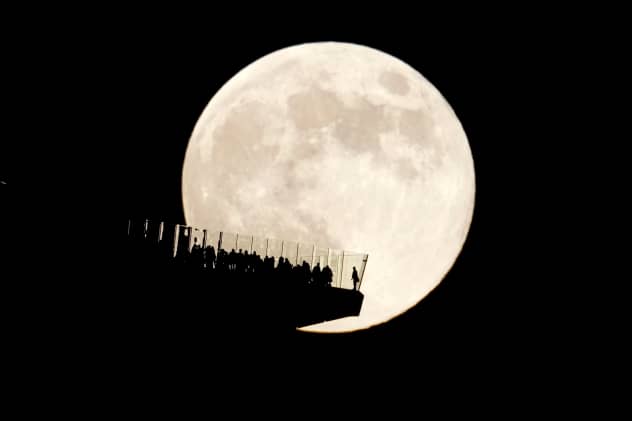
CLICK HERE TO JOIN OUR WHAT’S APP GROUP
Super Harvest Moon, 2 meteor showers to light up October nights
The first supermoon of 2025 will kick off a busy month for stargazers. Here are the top astronomy events to mark on your October calendar.
By Brian Lada, AccuWeather meteorologist and senior content editor
While the northern lights typically glow with a greenish hue, an astronaut aboard the International Space Station recently captured a breathtaking aurora streaked with crimson as it danced across Earth’s atmosphere.
The long and crisp autumn nights in North America will set the stage for a good month for stargazing, as the night sky will have a variety of events for folks of all ages—including two meteor showers. Here are the top astronomy events to mark in your calendar for October.
Super Harvest Moon: Oct. 6
October will begin with a lunar standout: the first of three consecutive supermoons. Supermoons appear slightly larger and brighter than other full moons, thanks to the moon’s closer-than-usual distance from Earth.
This one carries extra significance. It’s also the Harvest Moon, the title given to the full moon closest to the autumn equinox. Typically, this takes place in September, but 2025 is one of the uncommon years when it occurs in early October.

A supermoon rises behind an observation deck in New York City as seen from Hoboken, N.J., Friday, Nov. 15, 2024. (AP Photo/Seth Wenig)
The result will be a Super Harvest Moon shining on the night of Monday, Oct. 6, into the morning of Tuesday, Oct. 7.
Draconid meteor shower: Oct. 8-9
The Draconids are first on October’s meteor calendar, peaking from Wednesday night, Oct. 8, into the early morning of Thursday, Oct. 9.
This is a minor shower, typically producing up to 10 meteors an hour. The nearly full moon will wash out many faint streaks this year, but brighter meteors could still catch the eye.

In this long exposure photo, a streak appears in the sky at the Guadarrama mountains, near Madrid, in the early hours of Aug. 12, 2016. (AP Photo/Francisco Seco)
Unlike most showers, the Draconids are best viewed in the evening hours before midnight, according to EarthSky. Meteors can appear anywhere in the sky.
Orionid meteor shower: Oct. 22-23
One of the best meteor showers of autumn will peak on the night of Wednesday, Oct. 22, into the morning of Thursday, Oct. 23, as the Orionids peak.
This year is expected to be a good year for viewing as the shower coincides with the new moon, meaning the sky will be extra dark, especially compared to the Draconids earlier in October. Onlookers may count around 20 shooting stars per hour, according to the American Metoer Society.

Betelgeuse glowing orange in the constellation Orion. (Pixabay/sl1990)
The Orionids are named for the constellation Orion, from which the meteors appear to radiate. A few may appear earlier in the night, but activity will pick up as Orion rises higher in the sky after midnight.
CLICK HERE TO JOIN OUR WHAT’S APP GROUP
CLICK HERE TO JOIN OUR WHAT’S APP GROUP
CLICK HERE TO JOIN OUR WHAT’S APP GROUP
CLICK HERE TO JOIN OUR WHAT’S APP GROUP
CLICK HERE TO JOIN OUR WHAT’S APP GROUP
CLICK HERE TO JOIN OUR WHAT’S APP GROUP
CLICK HERE TO JOIN OUR WHAT’S APP GROUP
CLICK HERE TO JOIN OUR WHAT’S APP GROUP
CLICK HERE TO JOIN OUR WHAT’S APP GROUP
CLICK HERE TO JOIN OUR WHAT’S APP GROUP
CLICK HERE TO JOIN OUR WHAT’S APP GROUP
CLICK HERE TO JOIN OUR WHAT’S APP GROUP
CLICK HERE TO JOIN OUR WHAT’S APP GROUP
Advertise with the mоѕt vіѕіtеd nеwѕ ѕіtе іn Antigua!
We offer fully customizable and flexible digital marketing packages.
Contact us at [email protected]


















Good afternoon thanks for the good knowledge each one teach one we thank you let Jah be praise
Comments are closed.